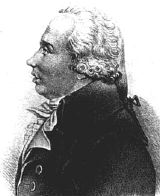

There are few details of Adrien-Marie Legendre's early life. He certainly came from a wealthy family who lived in Paris, and he was given a top quality education in mathematics and physics at the Collège Mazarin. At the age of 18, Legendre defended his thesis in mathematics and physics there but this was not quite as grand an achievement as it sounds to us today, for this consisted more of a plan of research rather than a completed thesis. With no need for employment to support himself, Legendre lived in Paris and concentrated on research.
From 1775 to 1780 he taught with Laplace at Ecole Militaire. He then decided to enter for the 1782 prize on projectiles offered by the Berlin Academy. His essay won the prize and launched Legendre on his research career, as he came to the notice of Lagrange, then
Director of Mathematics at the Academy in Berlin.
Legendre next studied the attraction of ellipsoids, leading to the introduction of what we call today the Legendre functions. Within a few days Legendre was appointed an adjoint in the Académie des Sciences filling the place which had become vacant when Laplace was promoted.
Over the next few years Legendre published work in a number of areas. In particular he published papers on celestial mechanics which contain the Legendre polynomials. He also published papers on number theory and the theory of elliptic functions. A 1785 paper on number theory contains a number of important results, such as the law of quadratic reciprocity for residues, and the results that every arithmetic series with the first term coprime to the common difference contains an infinite number of primes.
Legendre became an associé in 1785, and then in 1787 he was a member of the
team to make measurements of the Earth involving a triangulation survey between the
Paris and Greenwich observatories. This work resulted in his election to the Royal Society of London in 1787 and also to an important publication which contains Legendre's theorem on spherical triangles.
In 1791, Legendre became a member of the committee of the Académie des Sciences with the task to standardise weights and measures. The committee worked on the metric system. In 1792, he supervised the major task of producing logarithmic and
trigonometric tablesHe had between 70 to 80 assistants and the work was undertaken over a period of years, being completed in 1801.
In 1794, Legendre published Elélments de géométrie, which was the leading elementary text on the topic for around 100 years. This text greatly rearranged and simplified many of the propositions from Euclid's Elements to create a more effective textbook.
Legendre published a book on determining the orbits of comets in 1806.
His method involved 3 observations taken at equal intervals and he assumed that the comet followed a parabolic path so that he ended up with more equations
than there were unknowns. Legendre gave the least squares method of fitting a curve to
the data available.
Legendre's major work on elliptic functions appeared in 3 volumes in 1811, 1817, and 1819. In the first volume Legendre
introduced basic properties of elliptic integrals and also of beta and gamma functions. More results on beta and gamma functions appeared in the second volume
together with applications of his results to mechanics, the rotation of the Earth, the attraction of ellipsoids and other problems. The third volume was largely
devoted to tables of elliptic integrals.